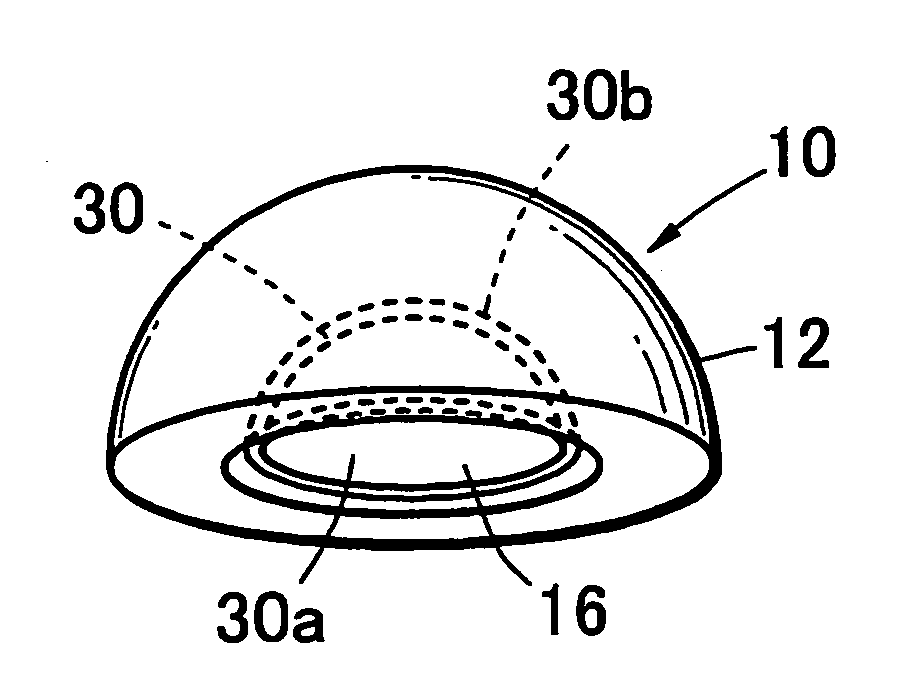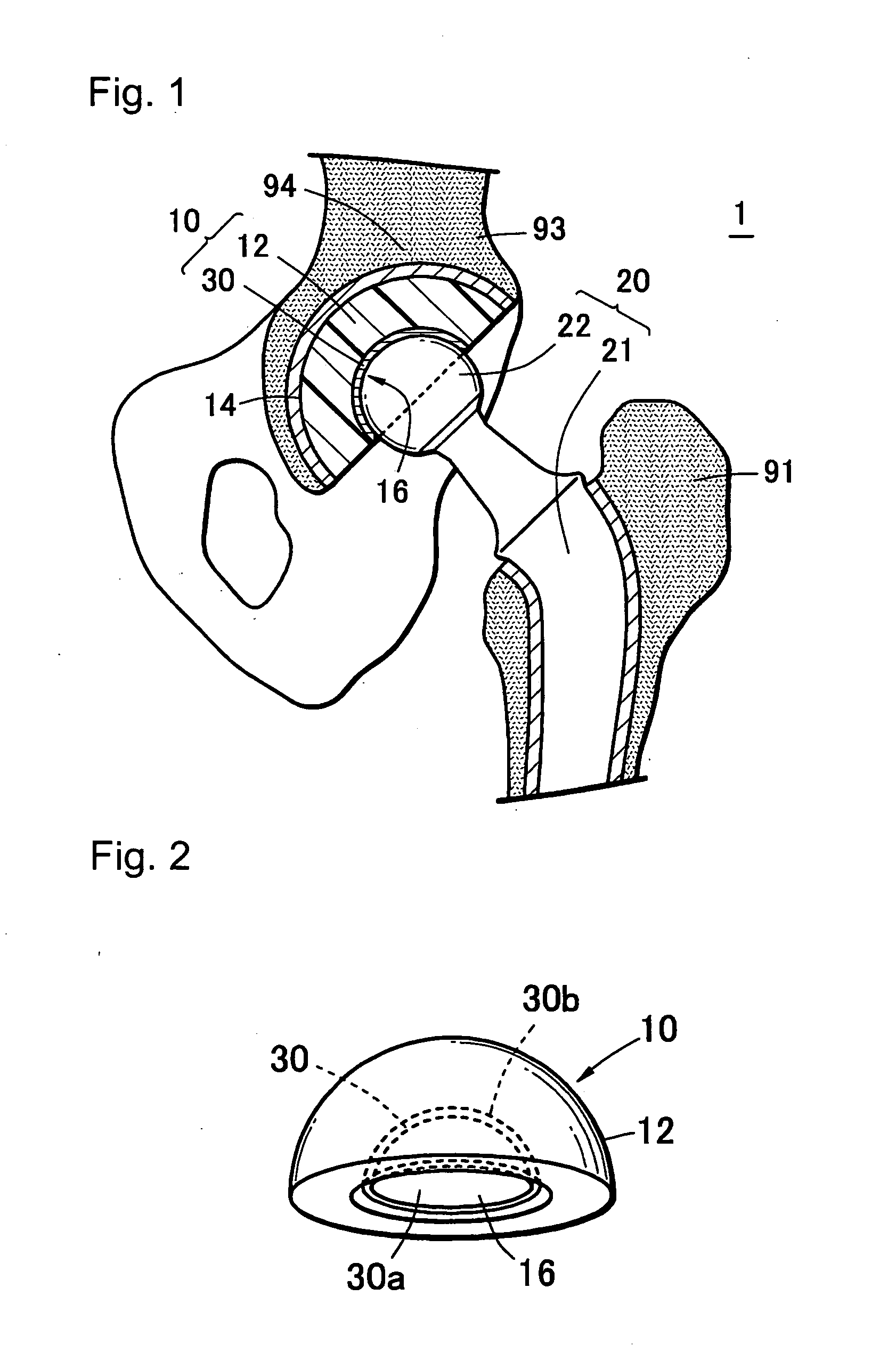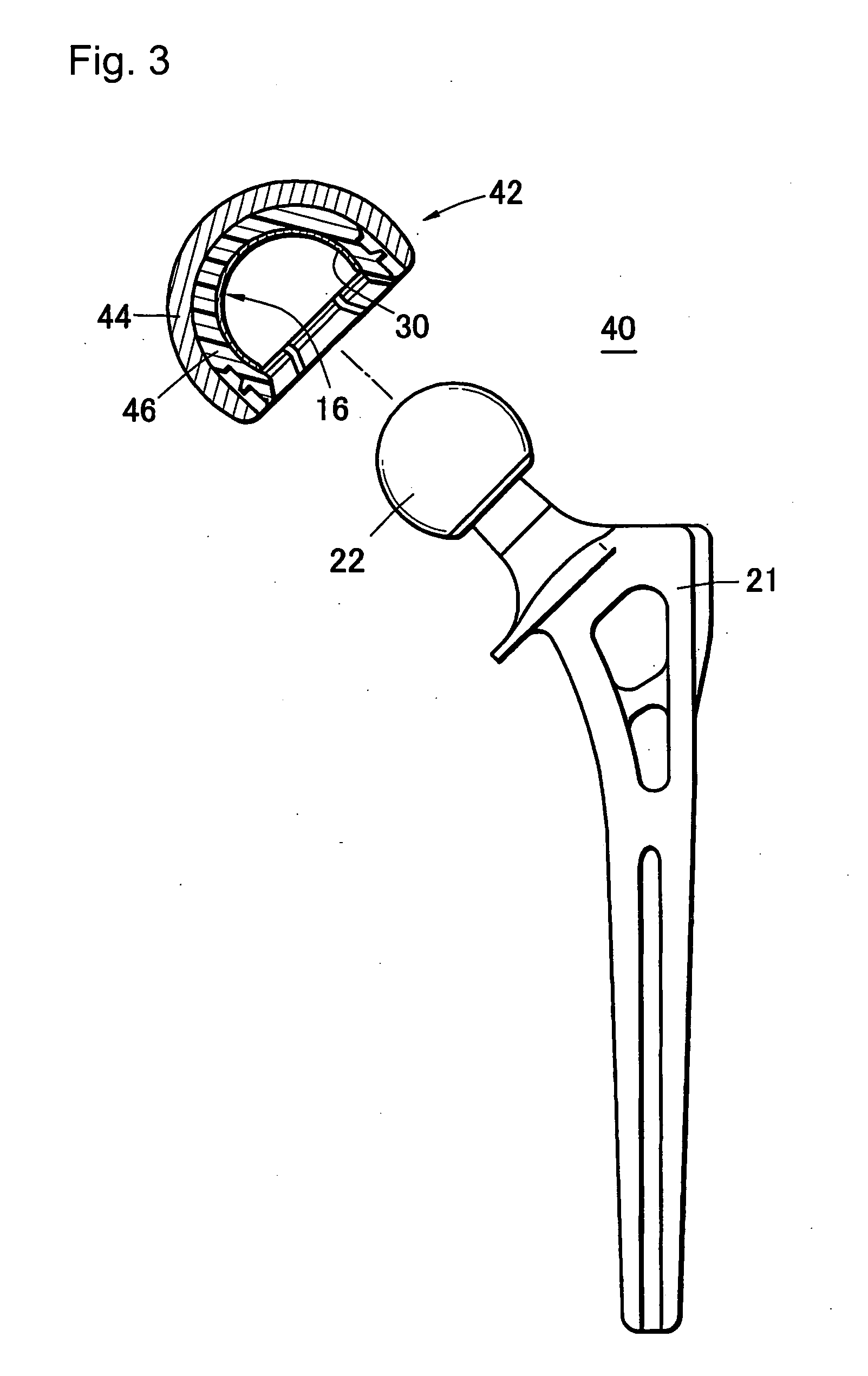High Wear-Resistant Bearing Material and Artificial Joint Replacement Using the Same
a bearing material and high wear resistance technology, applied in the direction of femoral head, shoulder joint, prosthesis, etc., can solve the problems of inability to completely prevent the wear of the bearing surface, the potential of osteolysis, and the burden on the patient, so as to achieve excellent durability, maintain high wear resistance over a long period of time, and avoid osteolysis
- Summary
- Abstract
- Description
- Claims
- Application Information
AI Technical Summary
Benefits of technology
Problems solved by technology
Method used
Image
Examples
first embodiment
[0073]FIG. 1 is a schematic diagram of an example of artificial joint, an artificial hip joint 1. The artificial hip joint 1 is constituted from a bearing component (acetabular cup) 10 that is fixed onto acetabulum 94 of a hip bone 93 and a femoral stem 20 that is fixed onto a proximal end of a femur 91. The acetabular cup 10 comprises a cup substrate 12 that has a substantially semi-spherical acetabulum fixing surface 14 and a bearing surface 16 of concave semi-spherical shape, and a polymer layer 30 with which the sliding surface 16 is covered. A bone head 22 of a femoral stem 20 is slidably fitted to the bearing surface 16 of the acetabular cup 10, so as to function as a hip joint.
[0074]As shown in FIG. 1 and FIG. 2, the acetabular cup 10 of the present invention is constituted by graft-coating the bearing surface 16 of the cup substrate 12 with a polymer layer 30 having a phosphorylcholine group. The polymer layer 30 has such a molecular structure as polymer chains having a phos...
second embodiment
[0100]FIG. 3 shows another artificial hip joint, a bipolar artificial hip joint 40. This artificial hip joint 40 is characterized by the constitution of the femoral head portion that comprises two components of a ball-shaped femoral head 22 and an outer head 42 that accommodates the femoral head 22.
[0101]The femoral head 22 consists of a ball-shaped component made of ceramics or a metal, and is fixed onto a stem body 21 at a proximate portion thereof.
[0102]The outer head 42 is constituted from an outer shell 44 that is a semi-spherical hollow component made of a metal or ceramics, a liner substrate 46 made of UHMWPE fixed onto the inside of the outer shell 44, and the polymer layer 30 fixed onto the spherical sliding surface 16 that is formed in the liner substrate 46. The liner substrate 46 and the polymer layer 30 constitute the bearing materials of the artificial joint. The polymer layer 30 is made of polymer chains having a phosphorylcholine group grafted on the sliding surface ...
third embodiment
[0105]FIG. 4 shows an artificial shoulder joint 70 that is constituted from a bearing component (glenoid cavity cup 15) that is fixed in the glenoid cavity of a shoulder blade and a humeral stem 25 that is fixed onto the humerus at the proximal end thereof.
[0106]The humeral stem 25 is constituted from a stem body 26 that is inserted into bone marrow of the humerus, and a humeral head 27 made of a metal or ceramics in substantially semi-spherical shape that is fixed onto proximal end of the stem body 26.
[0107]The glenoid cavity cup 15 comprises a cup substrate 17 that has a shoulder blade stem 19 embedded in the glenoid cavity of a shoulder blade and a bearing surface 16 formed in a shallow concave shape, and the polymer layer 30 formed to coat the bearing surface 16. Similarly to the first embodiment, the polymer layer 30 is made of polymer chains having a phosphorylcholine group grafted from the bearing surface 16.
[0108]The artificial shoulder joint 70 functions as a shoulder joint...
PUM
| Property | Measurement | Unit |
|---|---|---|
| thickness | aaaaa | aaaaa |
| static-water contact angle | aaaaa | aaaaa |
| static-water contact angle | aaaaa | aaaaa |
Abstract
Description
Claims
Application Information
 Login to View More
Login to View More - R&D
- Intellectual Property
- Life Sciences
- Materials
- Tech Scout
- Unparalleled Data Quality
- Higher Quality Content
- 60% Fewer Hallucinations
Browse by: Latest US Patents, China's latest patents, Technical Efficacy Thesaurus, Application Domain, Technology Topic, Popular Technical Reports.
© 2025 PatSnap. All rights reserved.Legal|Privacy policy|Modern Slavery Act Transparency Statement|Sitemap|About US| Contact US: help@patsnap.com



